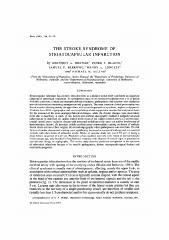Please use this identifier to cite or link to this item:
https://ahro.austin.org.au/austinjspui/handle/1/10931| Title: | The stroke syndrome of striatocapsular infarction. | Austin Authors: | Donnan, Geoffrey A ;Bladin, Peter F ;Berkovic, Samuel F ;Longley, W A;Saling, Michael M | Affiliation: | Department of Neurology, Austin Hospital, Melbourne, Australia | Issue Date: | 1-Feb-1991 | Publication information: | Brain : A Journal of Neurology; 114 ( Pt 1A)(): 51-70 | Abstract: | Striatocapsular infarction has recently been described as a distinct stroke entity and forms an important subgroup of subcortical infarctions. In a prospective study of 50 consecutive patients over a 10 yr period with this syndrome, clinical and neuropsychological features, pathogenesis and outcome were studied to provide information concerning management and prognosis. The most common clinical presentation was that of a stroke affecting mainly the upper limb with cortical signs such as dysphasia, neglect or dyspraxia. Evidence from EEG, angiographic and neuropsychological data supported a vascular/haemodynamic basis for the presence of the acute neuropsychological changes, while the chronic changes were more likely to be due to diaschisis. A study of risk factors and cerebral angiography enabled 4 pathophysiological subgroups to be identified: (1) cardiac emboli to the origin of the middle cerebral artery; (2) severe extra-cranial cranial carotid artery occlusive disease with presumed embolism to the same site and/or involvement of haemodynamic factors; (3) proximal middle cerebral artery abnormalities causing occlusion of multiple lateral striate arteries at their origins; (4) normal angiography where pathogenesis was uncertain. The risk factors of cardiac disease and smoking were significantly increased as compared with age and sex-matched controls with other forms of ischaemic stroke. Stroke or vascular death rate was 2.7% per yr during a mean follow-up period of 2.25 yrs. Predictors of an excellent recovery with return to normal lifestyle were younger age, only brachial or brachiofacial weakness with absence of cortical signs at presentation and minimal change on angiography. This stroke entity deserves particular recognition in the spectrum of subcortical infarctions because of its specific pathogenesis, distinct neuropsychological features and reasonable prognosis. | Gov't Doc #: | 1998890 | URI: | https://ahro.austin.org.au/austinjspui/handle/1/10931 | Journal: | Brain | URL: | https://pubmed.ncbi.nlm.nih.gov/1998890 | Type: | Journal Article | Subjects: | Cerebral Angiography Cerebral Infarction.physiopathology.radiography Cerebrovascular Disorders.physiopathology.radiography Corpus Striatum.physiopathology.radiography Female Humans Male Middle Aged Neuropsychological Tests Prognosis Prospective Studies Risk Factors Syndrome Tomography, X-Ray Computed |
| Appears in Collections: | Journal articles |
Files in This Item:
| File | Description | Size | Format | |
|---|---|---|---|---|
| 1998890.pdf | 5.65 MB | Adobe PDF |  View/Open |
Page view(s)
46
checked on Nov 26, 2024
Download(s)
1,048
checked on Nov 26, 2024
Google ScholarTM
Check
Items in AHRO are protected by copyright, with all rights reserved, unless otherwise indicated.
